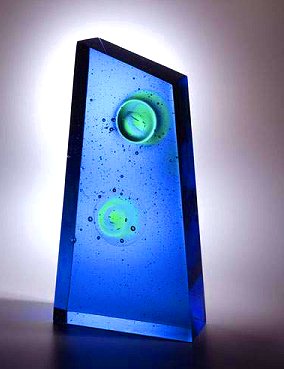GLASS QUARTERLY
Review:
Henry Hillman, Jr.
at Elizabeth Leach Gallery (Portland, Oregon)
by Richard Speer
Somewhere within Henry Hillman, Jr.’s Glass Castings, the prehistoric and futuristic meet. Their elemental geometries evoke primordial symbology, even as their immaculate execution and microcosmic spires and skyscrapers conjure gleaming cityscapes straight out of Lang’s Metropolis. Holding forth with a cryptic, Stonehenge-meets-Space-Age iconicism, they seem born half of the past, half of a speculative morrow, while we, as viewer, regard them quizzically from the fixed present, struggling to fathom their inscrutable designs. Based in Portland, Oregon, Hillman has been creating enigmas in glass since 1982, beginning in earnest but eventually becoming one of a handful of large-scale glass artists nationally to cast pieces from the sand up, tinting and hand-firing transparent glass blocks (often in excess of six inches thick) in custom-engineered kilns.These blocks make up the foundation of the eight works presented at Elizabeth Leach, three of which are what the artist dubs “architectonic towers,” girdered in their construction, imposing in their sheer scale. Plum Counter Bevel Tower stands 6.5 feet high and consists of twenty beveled glass blocks stacked one atop the other in a kind of etude to juxtaposition, the bevels alternating directionality, right to left, as they ascend. Of Blue Green Convex Tower’s 21 blocks, four are light blue, the rest hunter green, their chromatic placement more intuitive than considered, yet no less appealing for it. There is a visual smoothness about this tower that nicely contrasts with Blue and Green Half Moon Tower, which is smooth only in front; Hillman has used a chisel to chip pieces off the back, such that the disconcerted viewer beholds the scarred backside through a highly polished front. Moreover, the blocks are irregularly color-spaced as they rise upward: two green here, one blue there, one green, and so on, terminating in three blue blocks at the crown. While the schema makes little sense by any color-weighting standard, the sum impression could not be jauntier. Light spills from one block to the next, mixing together as it flows through green and blue, fooling the eye into reading the components as oceanic rather than discrete, with an overarching chromatic impression of aqua. Easily the most mesmerizing piece in the show, the work, with its pock-marked background rippling beneath a sleek fore, suggests the undulations of waves: a vertical reef, as it were, singing of seaweed, lagoons, and lei-laden Bali-Hai reverie. Which is to say, the whole enterprise emanates a limpid, liquid glamour firmly grounded in Romantic sensibilities, despite Hillman’s essentially minimalist modus operandi.
And then there is Green Ingot Spiral with Purple, in which bullion-like bars twist and turn a full four-and-a-half times as they climb, like a building by Santiago Calatrava. That this and the other towers harken back to totem poles, is notable in light of the totemic imagery so prevalent among the Native populations of the Pacific Northwest/British Columbian region in which Hillman lives and makes art. Yet it is not the totem that directly inspires the artist, but rather, as he relates in his artist statement, the Classical column, with its base, shaft, and capital. Whether antediluvian or Greco-Roman in their creative genesis, the towers, held together by steel supports, manage to meld ancient and science-fiction arcana in the same mien. One thinks of the famous monolith in Clarke’s and Kubrick’s 2001: A Space Odyssey, so basic in its primal geometry as to strike awe-dumbed fear in the hearts of ape and man, yet so preternaturally faultless in execution as to evince intelligent design.
Unlike that monolith, however, Hillman’s works, far from black and brooding, are brilliantly colored in jewel tones of citrine, emerald, and blue topaz. Their titles, such as Light Green, Yellow Top, have a dry utility that belies the subtleties of their hues and the way in which their colors shift, often radically, according to the vantage from which they are regarded. Many of the smaller pieces feature inclusions inserted during the casting process. In one such piece, Light Green Bevel, Yellow and Blue Inclusions, a dramatic inclusion stares out unnervingly like a giant eyeball with a transparent pupil, lapis-colored iris, and fierce yellow where the whites should be. On either side of the quadrilateral Blue with Two Inclusions, greenish protrusions bulge out as bubbles dance within the transparent interior, a space that Hillman calls “the fourth dimension” and whose properties he pointedly exploits across his output. It is this inner space, combined with the Lego-like piling of element upon element, that the artist employs in pursuit of his stated goal, “a balance between architecture, craft, construction, and fine art.” In his soaring towers, the physicality that informs his casting process, and his seemingly naïve flair for evocative forms, Hillman is achieving the synthesis he seeks, one block at a time.
—A contributing critic to ARTnews and Art, Ltd., Richard Speer is the author of Matt Lamb: The Art of Success (John Wiley & Sons) and is visual arts critic at Willamette Week, the Pulitzer Prize-winning alternative weekly in Portland, Oregon. He has written about cultural matters for Newsweek, Salon, The Los Angeles Times, and Opera News.
